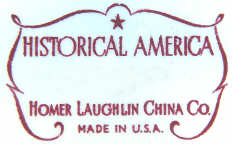|
In late 1941, the Homer Laughlin China Co. made plans to produce a line which would feature early American scenes reproduced from Joseph Boggs Beale paintings as a Woolworth's exclusive. Beale (1841-1926) was an American artist well known for historical and religious illustrations. The new shape was named, Liberty. The name was probably given to reflect the patriotic theme of the Beale treatments. One of the first mentions in Frederick Rhead's journals regarding the new line occurred on December 23, 1941: Mr. J.M. Wells also asked about the subjects for the Beale series. Understand that the series is to be done by the photo-engraved method.
The first Liberty piece modeled was the 9" plate on January 1942. After being accepted, the following items were created from mid-January to early March; 10", 8", 7", 6", plates, tea cup and saucer, sugar, oatmeal, creamer, deep plate, 8" and 9" nappies, 8" baker, and the 12" oval platter. Only two items were ultimately revised: the sugar and creamer which were remodeled with "flared tops."
From late March to June, work commenced on creating the various patterns for Liberty. On Monday, June 22, 1942, an entry in Rhead's journals discuss the new treatments: Beale samples out this afternoon. Could be a lot better printing. Most items lack detail and fine tonal variations. Work commenced on improving the quality of the prints, but on July 24, 1942, another change was made - this time with regard to the shape which resulted in a heavier and sharper gadroon edge. In August and September all the existing Liberty shapes were remodeled and a new items was added; the sauceboat.
Rhead was in failing health in mid 1942. From his journals, it's apparent he eventually died of mouth cancer, but he suffered from the condition for a long time. On April 29, 1941. he wrote: To Wheeling to see Phillips. Worried about mouth. Ordered me to go to Cleveland [Clinic] at once. Radium or surgery... For the rest of 1941 and into 1942, Rhead would make numerous entires about making trips the Cleveland Clinic. In late 1941, he spent fewer days at HLC. Work continued as usual and the production records were maintained. In mid-1942, Rhead would often come to work at noon or later in the day to oversee the progression of shapes and patterns - including Liberty.
It is noted several times in 1942 that Rhead would often leave the area. An entry from March 17, 1942 states: Mr. J.D. Thompson brought up the good news that Mr. Rhead is feeling much better and will probably be home around the twenty-ninth or thirtieth of this month. . He did in fact return, but eventually went to New York and was hospitalized in October. On November 3, 1942, Frederick Hurten Rhead died at the age of sixty-two. He was buried in New York two days later.
 Towards the end of '42, the revised Liberty shape and the perfected Beale patterns, now called, "Historical America" were put into production. Historical America in red was treatment number W-449 and blue was W-342. Two more items would be added in 1943: the covered casserole in February and the teapot in late March. Towards the end of '42, the revised Liberty shape and the perfected Beale patterns, now called, "Historical America" were put into production. Historical America in red was treatment number W-449 and blue was W-342. Two more items would be added in 1943: the covered casserole in February and the teapot in late March.
Historical America was produced for many years and is relatively easy to find in today's market. Red is by far the most common color, but blue examples can also be found. The Liberty shape was also used for decaled lines and other underglaze treatments. It became one of HLC's best selling shapes with production lasting until the 1960s. Historical America will have its own special mark along with the title of the Beale work, but decaled Liberty will carry the general HLC backstamp.
The flatware from Liberty and the Newell shape are not the same. The embossed rims may be similar, but each line has distinct rim size and scallop design. When it comes to the hollowware, Newell's embossed rope is placed on the rim, whereas Liberty's is low on the body. There's a bit of irony with these two similar shapes in that Newell was the first line Rhead designed for HLC and Liberty was his last.
|